Little-Known Event in History: Brooklyn Sanitary Fair
Many Americans are interested in the American Civil War (1861–1865). Let’s face it, the Civil War was a major turning point in American history. It paved the way for giving African Americans the vote and, ultimately, desegregation and the Voting Rights Act in the 1950s and 1960s. I find myself not so much interested in the political and military aspects of the war, but rather the social side.
The catastrophic casualties and destruction lead to a rise in the participation of American women in public service. At one point there were 3,000 volunteer nurses in the North alone. But that was not the only arena in which women served. I came across a series of lithographs for this Brooklyn Sanitary Fair of 1864. It’s absolutely fascinating and, at the risk of sounding like a broken record, it is more proof that there has never been a time in American history when women did not play a significant role.
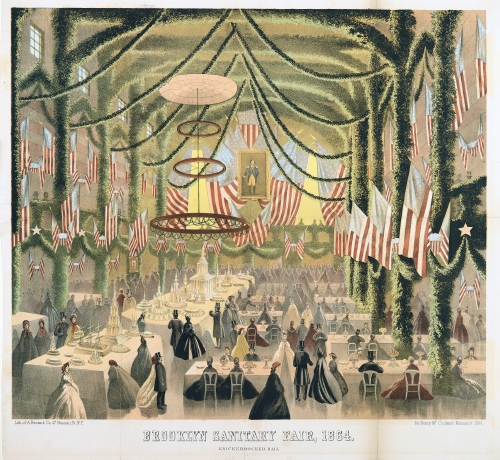 |
| Unknown artist (United States), Brooklyn Sanitary Fair, Knickerbocker Hall, published in Henry McCloskey’s Manual of the Common Council for the City of Brooklyn 1864. Chromolithograph on paper, 14 1/16" x 16 1/4" (35.7 x 41.2 cm). © Brooklyn Museum, Brooklyn, NY. (BMA-1654) |
The United States Sanitary Commission was founded by the federal government after the outbreak of the war. Its mission was to supply safe, healthy supplies to Union soldiers. Already in 1861 the government was aware that four out of five deaths in the war were caused by diseases related to poor medical attention or sanitary conditions, not from battle. While men were the fighting force of the war, women were the backbone of the Sanitary Commission, working with laundry, cooking, sewing, and—most of all—nursing. Taking place across the northern states, the series of “Sanitary Fairs” were organized by charitable women’s organizations, and raised $25 million toward the relief of sick and wounded Union soldiers.
The Brooklyn Sanitary Fair was organized by Brooklyn women. It was housed on the grounds of the Brooklyn Academy of Music, on which two temporary structures were erected to house a wide-ranging group of exhibits, from fine art and “curiosities” to regional cuisine and an ice-skating rink. Knickerbocker Hall was a temporary structure that housed a restaurant in which delicacies were served, staffed completely by women volunteers. The fair lasted from February 22 to March 8, 1864, netting donations of over $400,000, the modern equivalent of $4 million!
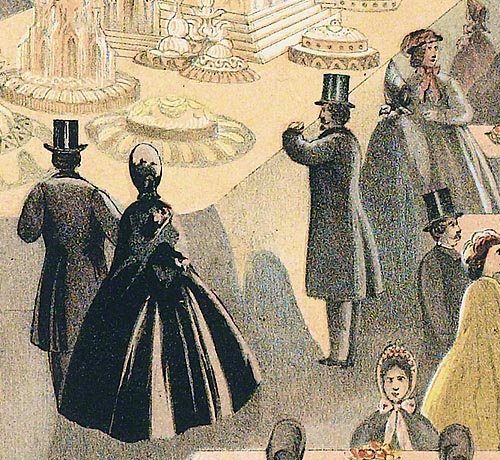 |
| Unknown artist (United States), Brooklyn Sanitary Fair, Knickerbocker Hall, detail, published in Henry McCloskey’s Manual of the Common Council for the City of Brooklyn 1864. |
Chromolithography evolved from the lithographic process as early as the 1830s. It involved the use of multiple stones copied from an original drawing, each stone printing a different color. The process became very popular for mass-production of color advertising. This image of Knickerbocker Hall is fascinating to me for the way the artist achieved an ambient lighting, and particularly for the emphasis on the numerous figures of women in giant crinolines (hoop skirts). It’s a hint of how important the role of women was during the Civil War.
Views of the fair:
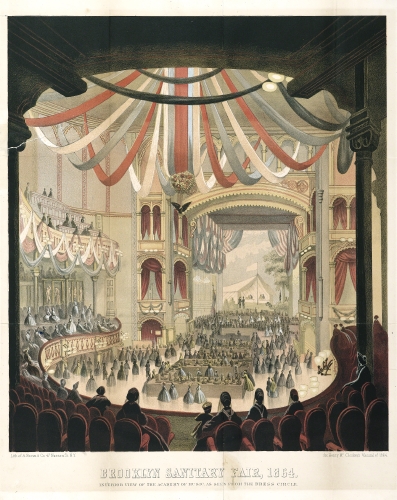 |
| Unknown artist (United States), Interior of the Academy of Music, from the Dress Circle, published in Henry McCloskey’s Manual of 1864. © Brooklyn Museum, Brooklyn, NY. (BMA-1867) |
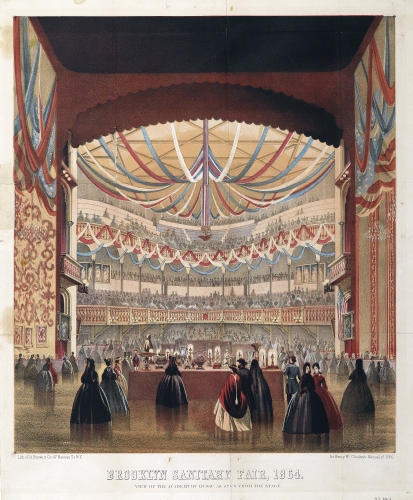 |
| Unknown artist (United States), View of the Academy of Music as Seen from the Stage, published in Henry McCloskey’s Manual of 1864. © Brooklyn Museum, Brooklyn, NY. (BMA-1657) |
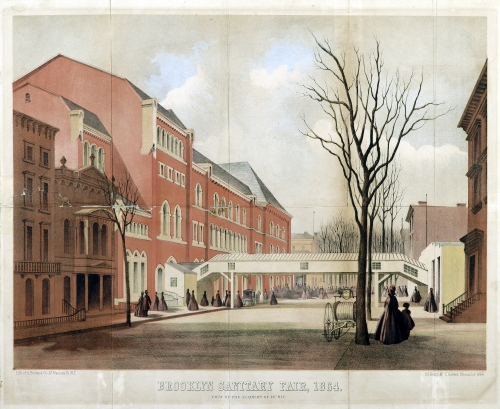 |
| Unknown artist (United States), View of the Academy of Music, published in Henry McCloskey’s Manual of 1864. © Brooklyn Museum, Brooklyn, NY. (BMA-1656) |
Studio activity: A collage of people in an important place. Using a piece of heavy construction paper, sketch the setting for a group of people at an important event in pencil. Then use colored pencils or markers to fill in the space. Using magazines cut out figures of people of varying sizes and overlap them on the construction paper to indicate a space full of people. Once finished, explain the nature of the event and why the figures were placed where they are.
Correlations to Davis programs: Explorations in Art Grade 2: 2.9, 2.10; Explorations in Art Grade 5: 1.3; 1.6; A Personal Journey: 2.4; Exploring Visual Design: 1, 5, 10; The Visual Experience: 9.4


Comments